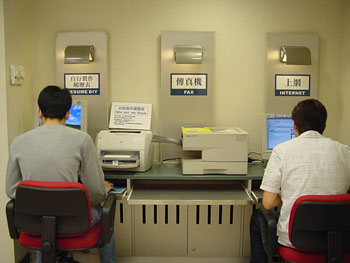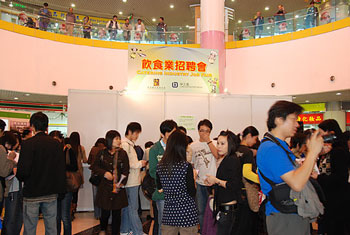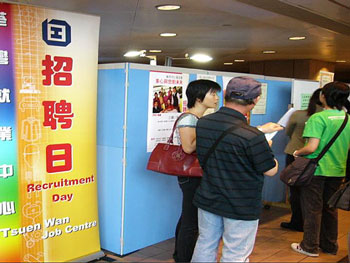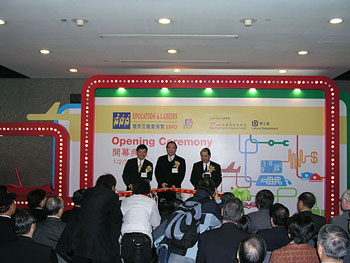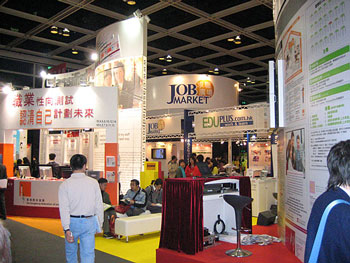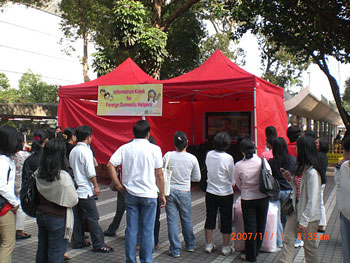Annual Report 2007
Chapter 5
Employment Services
The Programme of Employment Services
www.labour.gov.hk/eng/service/content.htmThe objective of the Employment Services Programme is to provide a comprehensive range of free and efficient employment assistance and counselling services to help job-seekers find suitable jobs and employers fill their vacancies. We achieve this by:
- providing user-friendly employment services to employers and job-seekers;
- offering intensive employment-related assistance and personal service to vulnerable groups of unemployed people;
- assisting young people to enhance their employability and advising them on careers choice;
- regulating local employment agencies;
- safeguarding the interests of local employees employed by employers outside Hong Kong to work in other territories; and
- ensuring that employment opportunities for local workers are not adversely affected by abuse of the labour importation scheme.
The two principal legislation administered by this programme area are the Employment Agency Regulations made under the Employment Ordinance and the Contracts for Employment Outside Hong Kong Ordinance.
The Employment Agency Regulations, together with Part XII of the Employment Ordinance, regulate the operation of employment agencies in Hong Kong through a licensing system, inspection, investigation and prosecution.
The Contracts for Employment Outside Hong Kong Ordinance safeguards the interests of local manual workers and those non-manual employees with monthly wages not exceeding $20,000 who are recruited by employers outside Hong Kong to work in other territories through the attestation of employment contracts for these jobs.
Our Work and Achievements in 2007
Employment Situation in Hong Kong
The labour market remained buoyant in 2007. The department received an all-time high of 559 815 vacancies from the private sector, an increase of nearly 17 per cent when compared with 479 942 in 2006. For updated statistics on the labour force, unemployment rate and underemployment rate, please visit the webpage: www.censtatd.gov.hk/hong_kong_statistics/statistical_tables/index.jsp?charsetID
=1&subjectID=2&tableID=006.
Key Indicators of Work
To better serve the public, the department vigorously stepped up its employment services for job-seekers. A record-high number of 135 489 placements was achieved in 2007, up almost 14 per cent over the level of 118 937 in 2006. (Figures 5.1 and 5.2)
A Wider Service Choice
Services offered at Job Centres
Job-seekers can select suitable vacancies and seek referral service at all job centres. Modern facilities such as digital display system, self-service touch-screen vacancy search terminals, fax machines, toll-free telephones, computers connected to the Internet and a resource corner are available.
Through the Job Matching Programme, placement officers help job-seekers evaluate their academic qualifications, job skills, work experience and job preferences, and encourage them to look for suitable jobs actively. Placement officers also introduce suitable retraining courses to job-seekers where appropriate.
Telephone Employment Service
Job-seekers registered at the Labour Department may call our Telephone Employment Service Centre on 2969 0888 for job referral service. Through conference calls, staff of the Centre can make arrangement for job-seekers to talk to employers directly.
Internet Employment Service
Our Interactive Employment Service (iES) website (www.jobs.gov.hk) provides round-the-clock Internet employment service and comprehensive employment information. The iES is one of the most popular government websites, accounting for 23 per cent of the page views for all government websites in Hong Kong. In 2007, the iES recorded over 922 million page views. It hyperlinks with leading employment websites in Hong Kong and hosts a number of dedicated webpages for specific clientele.
Central Processing of Job Vacancies
Employers who need to recruit staff can send their vacancy information to our Job Vacancy Processing Centre by fax (2566 3331) or telephone (2503 3377) or through the Internet (www.jobs.gov.hk). Vacancy information will be posted at all job centres and uploaded onto the iES in one working day.
Special Recruitment and Promotional Activities
We organise a variety of activities to promote our employment services and appeal for vacancies from employers. Recruitment seminars and job fairs are held to facilitate job-seekers and employers to meet and communicate directly. To assist job-seekers living in remote areas in securing employment, large-scale job fairs were held in Tung Chung, Tseung Kwan O, Shatin, Tuen Mun and Tin Shui Wai. Moreover, to respond more promptly to the recruitment needs of employers and provide a more user-friendly service to job-seekers of different districts, we held district-based job fairs at job centres to assist employers to recruit local staff and to enable job-seekers to participate in job interviews without having to travel long distance. These activities reached out to some 44 000 job-seekers in 2007.
Intensified Services for the Needy
Middle-aged Job-seekers
The Employment Programme for the Middle-aged was launched in May 2003 to assist the unemployed aged 40 or above to secure employment. Employers who engage an eligible middle-aged job-seeker in a full-time permanent job and offer him/her on-the-job training will receive a training allowance of $1,500 per month, for up to three months. As at the end of 2007, a total of 36 256 placements were secured through the programme.
Work Trial Scheme (WTS)
We launched the Work Trial Scheme in June 2005 to enhance the employability of job-seekers who have special difficulties in finding jobs. There is no age limit for applicants. During the one-month work-trial without employer-employee relationship, participants will be arranged to take up jobs offered by participating organisations. On satisfactory completion of the one-month work trial, the Labour Department will pay each participant an allowance of $4,500, while the participating organisation will contribute an additional allowance of $500. As at the end of 2007, a total of 1 669 job-seekers were placed into work trials.
Transport Support Scheme
Recognising the relative lack of job opportunities in the remoter parts of Hong Kong, the Labour Department introduced a pilot Transport Support Scheme in June to encourage needy unemployed and low-income employees living in the four remote districts of Tuen Mun, Yuen Long, North and Islands to seek jobs and work across districts. Under the scheme, time-limited transport allowances, viz. Job Search Allowance of up to $600 and Cross-district Transport Allowance of $600 per month for up to six months are made available to eligible applicants.
As at the end of 2007, the scheme had received 5 716 applications.
Local Domestic Helpers (LDHs)
To address the mismatch in supply and demand in the LDH market and to promote LDH service, the Special Incentive Allowance Scheme was launched in June 2003. A total sum of $70 million was earmarked to provide incentive allowance to qualified LDHs who are willing to work across districts or during unsocial hours (i.e. outside 9 am to 5 pm on Monday to Friday). Successful applicants will receive an allowance of $50 per day, with an overall cap of $7,200. As at year end, there were 11 756 approved applications.
The Scheme was extended to March 2008 to further promote the LDH market. To allow sufficient time for claiming allowance, participating LDHs can submit claims by October 2008 the latest.
New Arrivals
We provide through our job centres a comprehensive range of employment services to new arrivals. These include employment counselling, job referral, employment briefing and employment information.
Workers affected by Large-scale Retrenchment
In the event of major retrenchment, we will assign special counters at the job centres or render on-the-spot employment services to workers affected. In 2007, the service reached out to 1 899 retrenched workers of 11 companies.
Job-seekers with Disabilities
The Selective Placement Division (SPD) offers employment assistance to disabled job-seekers looking for open employment. Placement officers will provide personalised counselling, employment services and, where appropriate, make referrals to tailor-made retraining programmes. In 2007, the SPD registered 3 666 disabled job-seekers and helped place 2 619 of them into employment, representing an all-time high placement rate of 71.4 per cent. (Figure 5.3)
Work Orientation and Placement Scheme
The Labour Department launched the Work Orientation and Placement Scheme in April 2005 to enhance the employability of people with disabilities. The scheme features pre-employment training to disabled job-seekers on job-search/interviewing techniques and communication/interpersonal skills, etc, as well as a monthly allowance to the participating employers equivalent to half-month's wages of each disabled employee engaged (subject to a ceiling of $3,000) for up to three months. As at the end of 2007, the scheme recorded 920 disabled participants in this training programme and achieved 908 work placements.
Self Help Integrated Placement Service
The Self Help Integrated Placement Service (SHIPS) aims at improving the job-searching skills of disabled job-seekers and encouraging them to be more proactive in the search for jobs, thereby enhancing their employment opportunities. In 2007, 486 disabled job-seekers participated in the programme. The overall placement rate was about 70 per cent.
Interactive Selective Placement Service (iSPS) Website
The SPD launched an Interactive Selective Placement Service (iSPS) Website (www.jobs.gov.hk/isps) in January 2003 to provide enhanced employment services for disabled job-seekers and employers through the Internet. The website enables disabled persons to register or renew their registrations with the SPD, browse job vacancy information and perform preliminary job-matching. It also enables employers to place vacancy orders with the SPD, identify suitable disabled job-seekers to fill their vacancies and request the SPD to refer candidates to them for selection interview. Response to the iSPS has been very favourable. In 2007, it recorded a total of 2.14 million page views and 6 406 online requests for SPD's services.
Promotional Activities
During the year, the SPD produced a series of radio programmes to enhance public understanding of the working abilities of people with disabilities. We also held seminars for employers and conducted special promotional campaigns on targeted trades to canvass job vacancies.
Youth Work Experience and Training Scheme (YWETS)
The YWETS features: (1) 50 hours of career guidance and counselling services to trainees by case managers who are registered social workers; (2) 40 hours of induction training on communication and interpersonal skills for trainees; (3) a monthly training subsidy of $2,000 per trainee payable to employers during the training period; and a training allowance of $4,000 payable to trainees for undertaking off-the-job vocational training courses. As at the end of 2007, 36 326 trainees were successfully placed in training vacancies under the scheme. In addition, 17 690 trainees found other jobs with the assistance of their case managers.
In 2007, the YWETS continued to develop tailor-made projects for industries and individual establishments. Collaboration between the YWETS with the Youth Pre-employment Training Programme (YPTP) enables the running of "through train" training programmes under which pre-employment job skills training that meets a company's needs is provided under the YPTP, to be immediately followed by on-the-job training under the YWETS. This mode of training is well received by establishments and trainees. In 2007, 26 such tailor-made training-cum-employment projects were run for employers in the retail, catering, tourism, telemarketing, health care, real estate agency and property management industries.
Youth Pre-employment Training Programme (YPTP)
The YPTP provides a wide range of employment-related training and workplace attachment opportunities to young persons aged 15 to 19. Government departments, training bodies and voluntary agencies join hands to provide the following four modular training: (a) leadership, discipline and team building; (b) job-search and interpersonal skills; (c) elementary/ intermediate computer application; and (d) job-specific skills training. Organisations from the private and public sectors as well as social welfare agencies also offer workplace attachment places for trainees so that they can obtain practical work experience and better understand the real work environment. Professional youth workers are available to provide career counselling and support services throughout the programme. In 2007, about 6 500 young persons were provided with such training and workplace attachment opportunities. Apart from those pursuing further studies on completion of the programme, over 70 per cent of the trainees secured employment.
To maximise the benefits for trainees of the YPTP and the YWETS, a "Revolving Door" mechanism has been introduced by allowing them to move between the two programmes during a programme year. Together, the two programmes provide one-stop training and employment services to young people aged 15 to 24.

To encourage trainees to attend pre-employment training so as to enhance their employability, trainees of the 2007/08 Programme Year are entitled to a transport allowance of $30 per day, subject to attending at least 80 per cent of a YPTP modular course or the YWETS induction training.
Careers Information and Guidance
Our Careers Advisory Service promotes careers education and helps young people choose a career best suited to their talents, interest and abilities. Young people can visit our website (www.labour.gov.hk/careers) to gain quick access to a wide range of careers information.
Throughout the year, we arranged student group visits to various commercial and industrial establishments to enhance careers awareness among young people and provide them with first-hand careers information. In February, we organised the 17th Education and Careers Expo jointly with the Hong Kong Trade Development Council to provide the latest information on careers development and further education opportunities. There were 498 participating exhibitors from a wide range of trades, government departments, professional bodies, as well as local and overseas educational and training institutes. The event, which attracted 191 651 visitors, was the most popular careers information event in Hong Kong.
In December, the first youth employment resource centre named Youth Employment Start was set up to provide one-stop career advisory and employment support services to young people aged 15 to 29. The centre provides career assessment, career guidance, value-added training, support services on employment and self-employment as well as the latest labour market information to facilitate young people to map out their career path, enhance their employability and support young people to conduct their businesses.
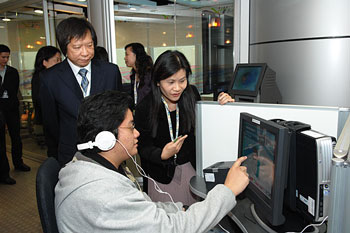
Regulating Local Employment Agencies and Employment Outside Hong Kong
We monitor the operation of employment agencies through licensing, inspection and investigation of complaints. In 2007, 1 830 employment agency licences were issued, one licence was revoked and renewal of one licence was refused. As at year-end, there were 1 782 licensed employment agencies in Hong Kong. A total of 1 086 inspections were made to employment agencies in the year.
We regulate employment outside the territory to safeguard the interests of local employees engaged by employers outside Hong Kong to work in other territories by attesting all employment contracts entered into in Hong Kong involving manual employees and non-manual employees with monthly wages not exceeding $20,000.
Regulating Labour Importation
Supplementary Labour Scheme
To cater for the genuine needs of employers, the department administers the Supplementary Labour Scheme that allows the entry of imported workers to take up jobs at technician level or below which cannot be filled locally. The scheme operates on the principles of ensuring the priority of local workers in employment while allowing employers with proven local recruitment difficulties to import labour to fill the necessary job vacancies.
We provide active job matching and referral services to local job-seekers to ensure their employment priority. Vacancies under the scheme are widely publicised locally. To facilitate local workers in filling the vacancies, they could attend tailor-made retraining courses, if appropriate. Applications from employers who have set restrictive or unreasonable requirements in terms of age, education, sex, skill or experience for the vacancies or who have no genuine intention to employ local workers will be rejected.
As at the end of 2007, there were 1 101 imported workers working in Hong Kong under the Supplementary Labour Scheme.
Policy on Foreign Domestic Helpers (FDHs)
FDHs have been admitted to work in Hong Kong since the 1970's. Like other migrant workers, FDHs enjoy the same statutory rights and benefits as local employees. They are further protected by a standard written employment contract and a Minimum Allowable Wage. The Government attaches great importance to protecting the welfare of FDHs, and has taken every step to safeguard their statutory and contractual rights. Claims of breach of statutory rights will be promptly investigated and prosecution action will be taken if there is sufficient evidence. In the year, the department also widely publicised the rights and benefits of FDHs by, for instance, staging one information expo and one information kiosk for FDHs at places they frequently gather on their rest days in February and November respectively. The two events attracted over 14 600 visitors. The Labour Department also maintained close liaison with consulates of the FDH-exporting countries and non-government organisations serving FDHs to better address the concerns of the helpers.
As at the end of 2007, there were 245 500 FDHs in Hong Kong, an increase of 5.5 per cent compared with 232 800 in 2006. About 50.3 per cent of the FDHs in Hong Kong were from the Philippines and 46.6 per cent from Indonesia.
